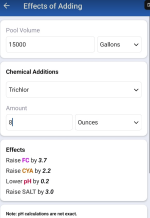Hi Everyone,
I am in Utah and this is our 3rd season with a salt water gunite pool. We wanted to open the pool a little early to work on the pool chemistry for a few weeks before it warms up. Temps in the low 40’s at night. Pool water is about at 45 upon opening. I was told since we opened the pool early we need to be heating the pool to at least 60 degrees due to the salt water generator. I am fine to do it if needed but would rather not if it’s unnecessary. I searched the forum before posting and didn’t see an answer to this particular question. Would love any help or advice on if this is true.
I am in Utah and this is our 3rd season with a salt water gunite pool. We wanted to open the pool a little early to work on the pool chemistry for a few weeks before it warms up. Temps in the low 40’s at night. Pool water is about at 45 upon opening. I was told since we opened the pool early we need to be heating the pool to at least 60 degrees due to the salt water generator. I am fine to do it if needed but would rather not if it’s unnecessary. I searched the forum before posting and didn’t see an answer to this particular question. Would love any help or advice on if this is true.


